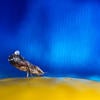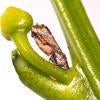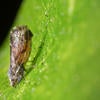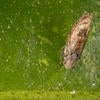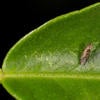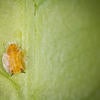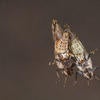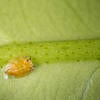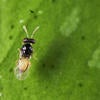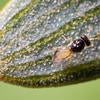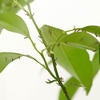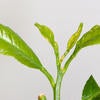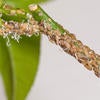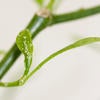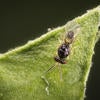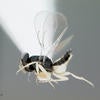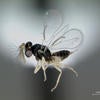Asian Citrus Psyllid, Diaphorina citri
The Situation: Asian citrus psyllid (ACP) is an efficient vector of the bacterial citrus disease huanglongbing (HLB), previously called citrus greening disease, which is one of the most destructive diseases of citrus worldwide. In the United States, the psyllid vector is found in Florida, Mexico, Louisiana, Georgia, South Carolina, Cuba, Belize and the Yucatan peninsula of Mexico. A federal quarantine restricts all movement of citrus and Rutaceae from into California in order to prevent introduction of the psyllid or the disease. The psyllid is under eradication in Southern California. If the psyllid and the disease were to become established in California, the disease would devastate the citrus industry.
Damage: ACP nymphs can only surive on the new flush tips of citrus. Because they produce a toxin, the flush tips die back or become twisted and the leaves do not expand normally. This problem can be reduced through pesticide control of the psyllid population or releases of natural enemies. A more important consequence of the introduction of ACP into California is its ability to vector the bacterial disease HLB. HLB causes assymetrical blotchy mottling of leaves (in contrast to Zinc deficiency that causes symmetrical blotching). Fruit from HLB-infected trees are small, lopsided, poorly colored, and contain aborted seeds. The juice from affected fruit is low in soluble solids, high in acids and abnormally bitter. The fruit retains its green color at the navel end when mature, which is the reason for the name citrus greening disease. The fruit is of no value because of poor size and quality. There is no cure for the disease and rapid tree removal is critical for prevention of spread.
Economic Impact: HLB is one of the most devastating diseases of citrus and since its discovery in Florida in 2005, citrus acreage in that state has declined significantly. Since the psyllid arrived in Southern California in 2008, the citrus nursery industry is rapidly moving its production under screenhouses. If the psyllid were to become
established in citrus growing region, pesticide treatments for the psyllid would be instituted resulting in a direct cost of greatly increased pesticide use (3-6 treatments per year) and indirect costs due to disruption of the integrated pest management program. If the disease were to appear in California, a costly eradication program would need to be instituted to remove infected trees in order to protect the citrus industry.
Distribution of ACP and HLB: ACP is found in Asia, parts of the Middle East, South and Central America Mexico and the Carribean. Asian citrus psyllid was first detected in backyard citrus in Southern California in August 2008. Surveys have found infestations in areas of San Diego and Imperial counties. ACP is also found in Florida, Louisiana, Georgia, South Carolina, Texas and Hawaii. HLB is present in China, eastern and southern Africa, the Indian subcontinent, Mauritius, Reunion, the Saudi Arabian peninsula, and southeast Asia. In 2005, HLB was found in Florida and it is now known to occur in Cuba, Belize, and Eastern Mexico The presence of HLB in Mexico increases the risk for introduction of the disease into California via psyllids or infected plant material.
Research: Research centers on characterization of the bacteria, development of HLB detection methods, and control of the disease and the psyllid. To date, control of the disease is based on planting HLB-free citrus germplasm, eradication of infected citrus plants, and control of the vector with systemic insecticides. Countries with HLB learn to manage the disease so that they can still produce citrus. In California, the best strategy to keep this disease out is to continue to prevent spread of the psyllid into citrus growing regions through insecticide treatments and support both the federal and state quarantine regulations and the University of California's Citrus Clonal Protection Program, which provides a mechanism for the safe introduction of pest and disease-free citrus germplasm into California.
More Media on the Asian Citrus Psyllid
LA Times: Citrus growers use predator wasp to fight disease threat
CISR Blog: First release of Tamarixia in California
UC Press Release: Scientist Release Natural Enemy of Asian Citrus Psyllid
Los Angeles Times: Scientist release wasps to control citrus pests
Los Angeles Times: Gardeners' common bond may have introduced deadly disease.
Scientific American: Can Scientists (and Wasps) Save Orange Juice?
Los Angeles Times: Predator wasp imported to combat deadly citrus disease
New York Times: A race to save the orange by altering its DNA
KPBS.org: Backyard Trees Might Spell Doom For San Diego’s Citrus Industry
Western Farm Press: Researcher pits nature against itself in ACP battle
UCR Today: How safe is the enemy of a citrus-threatening pest?
National Geographic: Can Parasitic Wasps Help Save America's Citrus?
The Packer: Psyllid natural enemy released in citrus grove
Press Enterprise: Second wasp to join citrus fight
The Atlantic: Florida Without Oranges
Los Angeles Times: Scientist use wasps to protect local citrus crops from disease
Executive Order: President Obama issues EO to Protect the US from Invasive Species
Power Point Presentation: "The Asian Citrus Psyllid and the Citrus Disease Huanglongbing"
Beth Grafton-Cardwell, UC Extension Specialist of Entomology
Brian Lehrer Show: The Threat to Orange Juice
KPCC The Madeleine Brand Show: California's Citrus Trees Could be in Trouble
The California Report: Fighting citrus pests with a natural predator. Or download the mp3 here
Hear and Now (90.0 WBUR): Can one insect save the citrus industry?
NPR: California Valley Guards Against Citrus Disease
The California Report: Infected LA lemon tree could be first of many
KPBS: Battling a small pest to keep California citrus flourishing
89.3 KPCC: Tiny 'vampire' wasps take on invasive citrus psyllid
NPR: Fighting Bugs With Bugs: Hatching A Solution For Troubled Trees
RESOURCES IN ESPAÑOL
UCANR: Special Stories - Psilido asiatico y HLB
UCANR: Hallazgo de huanglongbing amenaza cultivos de cítricos en California
UCANR: El huanglongbing en citricos de California
YouTube: UC Riverside scientist release enemy of Asian Citrus Psyllid
YouTube: Deep Look: How Hoverflies Spawn Maggots that Sweeten Your Oranges
CISR Video: Christina Hoddle talks about the Tamarixia radiata release at UCR
CBS: Wasp may save Valley citrus
KPBS: Battling a small pest to keep California citrus flourishing
ABC News: Citrus Industry steps up biological battle against pest
City of Riverside: Face2Face: Face2Face with Mark Hoddle
Invasive.org: Asian Citrus Psyllid
Center for Invasive Species Research University of California Riverside
Text provided by Elizabeth Grafton-Cardwell, Extension Specialist of Entomology
Photos by Mike Lewis, Center for Invasive Species Research
Elizabeth Grafton-Cardwell, Extension Specialist of Entomology
elizabeth.grafton@ucr.edu
KAC Citrus Website
Media within CISR is licensed under a Creative Commons Attribution-NonCommercial-NoDerivs 3.0 Unported License. Permissions beyond this scope may be available at www.cisr.ucr.edu/media-usage.


